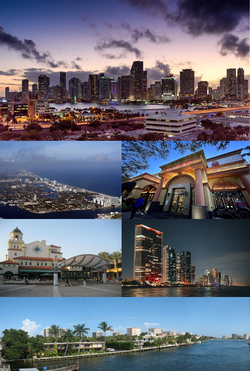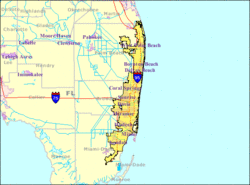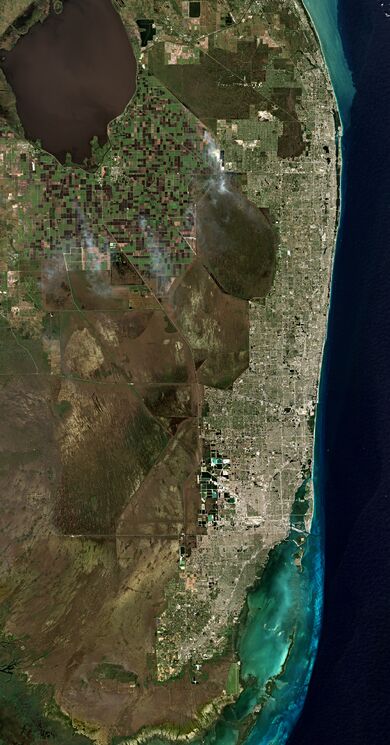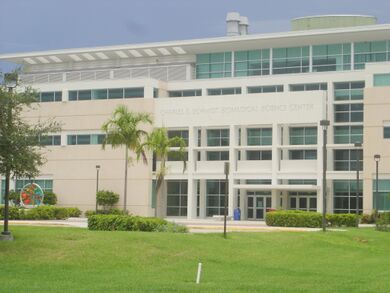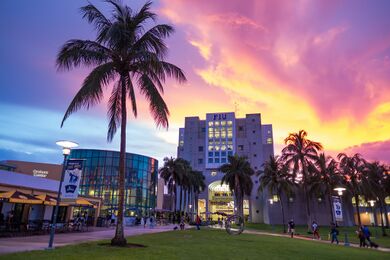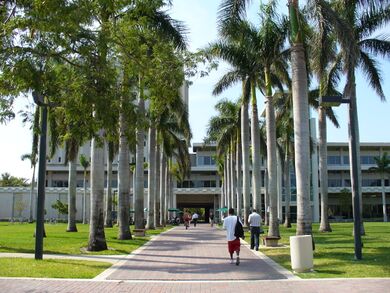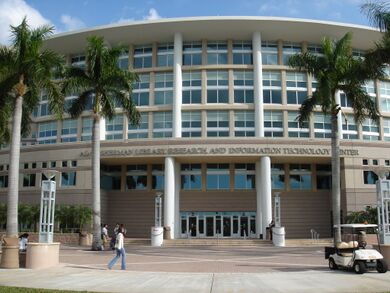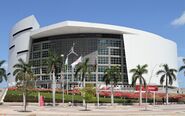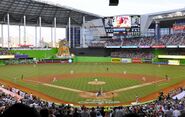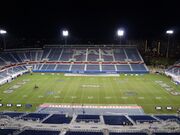منطقة ميامي العمرانية
منطقة ميامي العمرانية (also known as Greater Miami, the Tri-County Area, South Florida, SoFlo, or the Gold Coast) is the ninth-largest metropolitan statistical area in the United States and the 65th-largest metropolitan area in the world with a 2020 population of 6.138 million people.
With 1،279.2 sq mi (3،313 km2) of urban landmass, the Miami metropolitan area also is one of the most populous urban agglomerations in the world. The City of Miami is the financial and cultural core of the metropolis. The metropolitan area includes Miami-Dade, Broward, and Palm Beach Counties,[1] which rank as the first-, second-, and third-most populous counties in Florida. Miami-Dade, with 2,716,940 people in 2019, is the seventh-most populous county in the United States. The metropolitan area's principal cities include Miami, Fort Lauderdale, Pompano Beach, West Palm Beach, Boca Raton, Sunrise, Miami Beach, Deerfield Beach, Pembroke Pines, Kendall, Boynton Beach, Delray Beach, Jupiter, Doral, Palm Beach Gardens, and Coral Gables.[3] The Miami metropolitan area sits within the South Florida region, which includes the Everglades and the Florida Keys.
With an estimated 6,166,488 inhabitants as of 2019, the three counties collectively make up the Miami metropolitan area, which is the most populous in Florida and the second-largest in the Southeastern United States.[4][5][6][7]
Because the population of South Florida is largely confined to a strip of land between the Atlantic Ocean and the Everglades, the Miami urbanized area (that is, the area of contiguous urban development) is about 100 ميل (160 km) long (north to south), but never more than 20 ميل (32 km) wide, and in some areas only 5 ميل (8 km) wide (east to west). The Miami metropolitan statistical area is longer than any other urbanized area in the United States except for the New York metropolitan area.[8] It was the eighth most densely populated urbanized area in the United States in the 2000 census.[9]
As of the 2000 census, the urbanized area had a land area of 1،116 ميل مربع (2،890 km2), with a population of 4,919,036, for a population density of 4,407.4 per square mile (1,701.7 per km2). Miami and Hialeah, the second-largest city in the metropolitan area, had population densities of more than 10,000/sq mi (more than 3,800/km2).[10][11] The Miami Urbanized Area was the fourth-largest urbanized area in the United States in the 2010 census.
The Miami metropolitan area also includes several urban clusters (UCs) as of the 2000 Census, which are not part of the Miami urbanized area. These are the Belle Glade UC, population 24,218, area 20.717 km2 and population density of 3027.6/sq mi; Key Biscayne UC, population 10,513, area 4.924 km2 and population density of 5529.5/sq mi; Redland UC, population 3,936, area 10.586 km2 and population density of 963.0/sq mi; and West Jupiter UC, population 8,998, area 24.737 km2 and population density of 942.1/sq mi.[12]
The most notable colleges and universities in the Miami metropolitan area include Florida Atlantic University, Florida International University, Nova Southeastern University, and the University of Miami, as well as community colleges such as Broward College, Miami Dade College, and Palm Beach State College. Some of these institutions, such as Florida International University and Miami Dade College, make up some of the largest institutions of higher learning in the United States.[13]
تعريفات
Miami metropolitan area
اعتبارا من 2023[تحديث], the Miami metropolitan area is defined by the U.S. Office of Management and Budget as the Miami-Fort Lauderdale-Pompano Beach Metropolitan Statistical Area (MSA),[1] with a 2020 population of 6,138,333. The MSA is made up of three "metropolitan divisions" :
- Miami-Miami Beach-Kendall Metropolitan Division, coterminous with Miami Dade County (2020 population 2,701,767).
- Fort Lauderdale-Pompano Beach-Sunrise Metropolitan Division, coterminous with Broward County (2020 population 1,944,375).
- West Palm Beach-Boca Raton-Boynton Beach Metropolitan Division, coterminous with Palm Beach County (2020 population 1,492,191).[14]
The MSA is the most populous metropolitan area in the Southeastern United States and has an area of 6,137 sq. mi (15,890 km2).
The original MSA for Miami, as defined by the OMB, included only Dade County (now Miami-Dade County). By 1995, the Miami-Hialeah and Fort Lauderdale-Hollywood-Pompano Beach MSAs had been merged into the Miami-Fort Lauderdale Consolidated MSA, consisting of the Miami Primary MSA (Dade County) and the Fort Lauderdale Primary MSA (Broward County).[15] In 2003, the West Palm Beach-Boca Raton-Boynton Beach MSA was merged with the consolidated MSA to form the Miami-Fort Lauderdale-Miami Beach Metropolitan Statistical Area, consisting of: the Fort Lauderdale-Pompano Beach-Deefield Beach Metropolitan Division (Broward County), the Miami-Miami Beach-Kendall Metropolitan Division (Miami-Dade County), and the West Palm Beach-Boca Raton-Boynton Beach Metropolitan Division (Palm Beach County).[16]
Miami-Port Saint Lucie-Fort Lauderdale Combined Statistical Area
The Census Bureau also defines a wider commercial region based on commuting patterns, the Miami-Port Saint Lucie-Fort Lauderdale Combined Statistical Area (CSA), with a population of 6,887,655 in 2020.
اعتبارا من 2023[تحديث], the CSA consists of three component metropolitan statistical areas (MSAs) and one Micropolitan statistical area (μSA):
- The Miami-Fort Lauderdale-Pompano Beach MSA (2020 pop. 6,138,333)
- The Port Saint Lucie MSA (2020 pop. 486,660), consisting of:
- Martin County (2020 pop. 158,431)p. 28
- Saint Lucie County (2020 pop. 329,226)p. 28
- The Sebastian-Vero Beach MSA, coterminous with Indian River County (2020 pop. 159,788)
- The Key West μSA, coterminous with Monroe County (2020 pop. 82,874).[17][14]
When the CSA was defined in 2013, it included the Okeechobee μSA, coterminous with Okeechobee County, but not the Key West μSA. In 2018 the Okeechobee μSA was removed from the CSA and the Key West μSA was added.[18][19]
ساحل الذهب
The Miami metropolitan area is frequently named the "Gold Coast" in convention with Florida's other coast regions, including the Space Coast, Treasure Coast, Sun Coast, Nature Coast, Forgotten Coast, Fun Coast, and First Coast. Like several of the others, it seems to have originated at the time the area first saw major growth. One of the best known of Florida's vernacular regions, the name is a reference to the wealth and ritzy tropical lifestyle that characterizes the area.[20][21]
المناخ والجغرافيا
المناخ
South Florida/Miami metropolitan area has a tropical climate, similar to the climate found in much of the Caribbean. It is the only metropolitan area in the 48 contiguous states that falls under that category. More specifically, it generally has a tropical monsoon climate (Köppen climate classification, Am).[22] The South Florida metropolis sees most of its rain in the summer (wet season) and is quite dry in the winter (dry season). The wet season, which is hot and humid, lasts from May to October, when daily thunderstorms and passing weak tropical lows bring downpours during the late afternoon. The dry season often starts in late October and runs through late April. During the height of the dry season from February through April, South Florida is often very dry, and often brush fires and water restrictions are an issue. At times cold fronts can make it all the way down to South Florida and provide some modest rainfall in the dry season. The hurricane season largely coincides with the wet season.[23]
In addition to its sea-level elevation, coastal location and position near the Tropic of Cancer and the Caribbean, the area owes its warm, humid climate to the Gulf Stream, which moderates climate year-round. A typical summer day does not see temperatures below 75 °F (24 °C). Temperatures in the high 80s to low 90s (30–35 °C) accompanied by high humidity are often relieved by afternoon thunderstorms or a sea breeze that develops off the Atlantic Ocean, which then allow lower temperatures, although conditions still remain very muggy.
During winter, dry air often dominates as dew points are often very low. Average daily high temperatures across South Florida during the winter are around 74–77 °F (23–25 °C). Although daily highs can sometimes reach 82–85 °F (28–29 °C) even in January and February. Daily low temperatures during the winter are generally around 55–63 °F (13–17 °C). Each winter, cold fronts occasionally make their way down to the northern Bahamas and South Florida. As a result, daytime high temperatures in South Florida may only reach around 65 °F (18 °C) or cooler. When this occurs low temperatures can dip into the 40s during the early morning hours before quickly warming-up toward late morning/early afternoon. It is rare for temperatures to drop below 40 °F (4 °C), however, low temperatures at or around 35 °F (2 °C) have occurred some years. South Florida only experiences these cold spells about twice each winter and they typically only last a day or two before temperatures return to the mid 70s. On average South Florida is frost-free, although there can be a light frost in the inland communities about once every decade.
Hurricane season officially runs from June 1 through November 30, although hurricanes can develop outside that period. The most likely time for South Florida to be hit is during the peak of the Cape Verde season, mid-August through the end of September.[24] Due to its location between two major bodies of water known for tropical activity, South Florida is also statistically the most likely major area to be struck by a hurricane in the world, trailed closely by Nassau, Bahamas, and Havana, Cuba. Many hurricanes have affected the metropolis, including Betsy in 1965, Andrew in 1992, Irene in 1999, Hurricanes Katrina and Wilma in 2005, and Irma in 2017. In addition, a tropical depression in October 2000 passed over the city, causing record rainfall and flooding. Locally, the storm is credited as the No Name Storm of 2000, though the depression went on to become Tropical Storm Leslie upon entering the Atlantic Ocean.
| بيانات المناخ لـ West Palm Beach Airport, Florida (1981–2010 normals,[25] extremes 1888–present) | |||||||||||||
|---|---|---|---|---|---|---|---|---|---|---|---|---|---|
| الشهر | ينا | فب | مار | أبر | ماي | يون | يول | أغس | سبت | أكت | نوف | ديس | السنة |
| متوسط القصوى اليومية °ف (°س) | 75.2 (24.0) |
76.3 (24.6) |
80.0 (26.7) |
84.1 (28.9) |
87.0 (30.6) |
90.7 (32.6) |
92.0 (33.3) |
91.3 (32.9) |
88.3 (31.3) |
84.3 (29.1) |
82.3 (27.9) |
76.7 (24.8) |
84.3 (29.1) |
| متوسط الدنيا اليومية °ف (°س) | 57.4 (14.1) |
58.6 (14.8) |
61.7 (16.5) |
65.0 (18.3) |
71.1 (21.7) |
75.0 (23.9) |
75.2 (24.0) |
75.4 (24.1) |
74.3 (23.5) |
70.9 (21.6) |
63.4 (17.4) |
60.0 (15.6) |
66.8 (19.3) |
| متوسط تساقط الأمطار inches (mm) | 2.18 (55) |
2.09 (53) |
2.05 (52) |
2.03 (52) |
5.76 (146) |
9.02 (229) |
9.27 (235) |
9.83 (250) |
9.93 (252) |
9.57 (243) |
5.07 (129) |
2.27 (58) |
60.35 (1٬533) |
| Average rainy days (≥ 0.01 in) | 7.8 | 6.7 | 5.0 | 5.8 | 14.1 | 16.0 | 18.1 | 19.0 | 16.7 | 17.1 | 10.2 | 7.1 | 132.6 |
| Source: NOAA[26][27] | |||||||||||||
| بيانات المناخ لـ Fort Lauderdale Int'l Airport, Florida (1981–2010 normals, extremes 1912–present) | |||||||||||||
|---|---|---|---|---|---|---|---|---|---|---|---|---|---|
| الشهر | ينا | فب | مار | أبر | ماي | يون | يول | أغس | سبت | أكت | نوف | ديس | السنة |
| متوسط القصوى اليومية °ف (°س) | 75.5 (24.2) |
76.7 (24.8) |
78.5 (25.8) |
82.9 (28.3) |
85.6 (29.8) |
89.8 (32.1) |
91.9 (33.3) |
90.5 (32.5) |
88.8 (31.6) |
85.8 (29.9) |
81.0 (27.2) |
76.9 (24.9) |
83.3 (28.5) |
| متوسط الدنيا اليومية °ف (°س) | 59.0 (15.0) |
60.5 (15.8) |
63.4 (17.4) |
66.9 (19.4) |
72.0 (22.2) |
74.4 (23.6) |
75.9 (24.4) |
75.8 (24.3) |
75.2 (24.0) |
71.8 (22.1) |
65.7 (18.7) |
61.3 (16.3) |
67.7 (19.8) |
| متوسط تساقط الأمطار inches (mm) | 3.63 (92) |
2.96 (75) |
3.36 (85) |
2.89 (73) |
4.65 (118) |
10.16 (258) |
5.98 (152) |
7.44 (189) |
8.59 (218) |
6.82 (173) |
3.24 (82) |
2.46 (62) |
62.18 (1٬579) |
| Average rainy days (≥ 0.01 in) | 5.0 | 6.1 | 6.9 | 5.4 | 8.8 | 15.9 | 15.9 | 15.7 | 15.8 | 10.6 | 8.1 | 8.1 | 122.3 |
| Source: [28][29][30] | |||||||||||||
| بيانات المناخ لـ Miami Beach, 1981−2010 normals | |||||||||||||
|---|---|---|---|---|---|---|---|---|---|---|---|---|---|
| الشهر | ينا | فب | مار | أبر | ماي | يون | يول | أغس | سبت | أكت | نوف | ديس | السنة |
| متوسط القصوى اليومية °ف (°س) | 73.8 (23.2) |
74.9 (23.8) |
76.3 (24.6) |
79.4 (26.3) |
82.8 (28.2) |
86.5 (30.3) |
88.1 (31.2) |
88.5 (31.4) |
87.0 (30.6) |
83.7 (28.7) |
79.3 (26.3) |
75.7 (24.3) |
81.3 (27.4) |
| متوسط الدنيا اليومية °ف (°س) | 61.4 (16.3) |
63.0 (17.2) |
65.3 (18.5) |
69.2 (20.7) |
73.9 (23.3) |
77.0 (25.0) |
78.3 (25.7) |
78.6 (25.9) |
77.7 (25.4) |
74.7 (23.7) |
69.5 (20.8) |
64.3 (17.9) |
71.1 (21.7) |
| متوسط تساقط الأمطار inches (mm) | 2.09 (53) |
2.33 (59) |
3.00 (76) |
3.20 (81) |
4.98 (126) |
8.27 (210) |
4.35 (110) |
6.37 (162) |
7.88 (200) |
4.47 (114) |
2.74 (70) |
2.05 (52) |
51.73 (1٬313) |
| Average rainy days (≥ 0.01 in) | 6.7 | 6.0 | 6.9 | 6.0 | 8.9 | 14.5 | 12.1 | 14.0 | 14.9 | 11.2 | 8.1 | 6.9 | 116.2 |
| Source: NOAA (extremes 1927−present)[31] | |||||||||||||
المقاطعات المكونة والأقاليم الفرعية والمدن
أكبر المدن
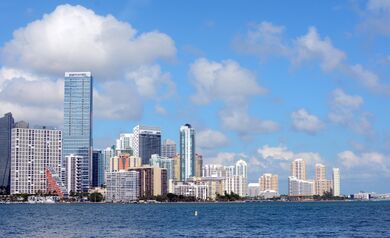
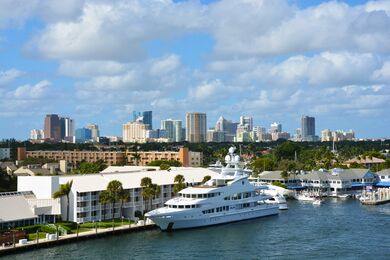
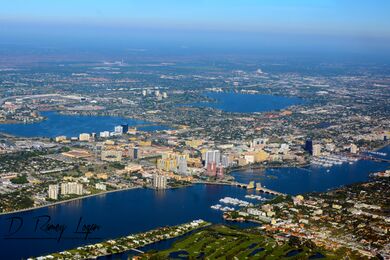
The following is a list of the twenty largest cities in the Miami metropolitan area as ranked by population.[32][33][34]
| المدينة | المقاطعة | تعداد 2000 |
تعداد 2010 |
تعداد 2020 |
% تغير تعداد 2020 |
|---|---|---|---|---|---|
| ميامي | Miami-Dade | 362,470 | 399٬457 | 442٬241 | +10٫71% |
| Hialeah | Miami-Dade | 226,419 | 224٬669 | 223٬109 | −0٫69% |
| Fort Lauderdale | Broward | 152,397 | 165٬521 | 182٬760 | +10٫41% |
| Pembroke Pines | Broward | 137,427 | 154٬750 | 171٬178 | +10٫62% |
| Hollywood | Broward | 139,357 | 140٬768 | 153٬067 | +8٫74% |
| Miramar | Broward | 72,739 | 122٬041 | 134٬721 | +10٫39% |
| Coral Springs | Broward | 117,549 | 121٬096 | 133٬394 | +10٫16% |
| Miami Gardens | Miami-Dade | 100,758 | 107٬167 | 111٬640 | +4٫17% |
| Pompano Beach | Broward | 78,191 | 99٬845 | 112٬046 | +12٫22% |
| West Palm Beach | Palm Beach | 82,103 | 99٬919 | 117٬415 | +17٫51% |
| Davie | Broward | 75,720 | 91٬922 | 105٬691 | +14٫98% |
| Boca Raton | Palm Beach | 74,764 | 84٬392 | 97٬422 | +15٫44% |
| Sunrise | Broward | 85,779 | 84٬439 | 97٬335 | +15٫27% |
| Plantation | Broward | 82,934 | 84٬955 | 91٬750 | +8�00% |
| Miami Beach | Miami-Dade | 87,933 | 87٬779 | 82٬890 | −5٫57% |
| Deerfield Beach | Broward | 64,583 | 75٬018 | 86٬859 | +15٫78% |
| Boynton Beach | Palm Beach | 60,389 | 68٬217 | 80٬380 | +17٫83% |
| Lauderhill | Broward | 57,585 | 66٬887 | 74٬482 | +11٫35% |
| Doral | Miami-Dade | 20,438 | 45٬704 | 75٬874 | +66٫01% |
| Homestead | Miami-Dade | 31,909 | 60٬512 | 80٬737 | +33٫42% |
Areas with between 10,000 and 100,000 inhabitants
- Aventura
- Belle Glade
- Boca Del Mar
- Boynton Beach
- Brownsville
- Coconut Creek
- Cooper City
- Coral Gables
- Coral Terrace
- Country Club
- Country Walk
- Cutler Bay
- Dania Beach
- Deerfield Beach
- Delray Beach
- Doral
- Florida City
- Fontainebleau
- Gladeview
- Glenvar Heights
- Goulds
- Greenacres
- Hallandale Beach
- Hamptons at Boca Raton
- Hialeah Gardens
- Homestead
- Ives Estates
- Jupiter
- Kendale Lakes
- Kendall West
- Kendall
- Key Biscayne
- Kings Point
- Lake Worth Corridor
- Lake Worth Beach
- Lauderdale Lakes
- Lauderhill
- Leisure City
- Lighthouse Point
- Margate
- Miami Beach
- Miami Lakes
- Miami Shores
- Miami Springs
- North Lauderdale
- North Miami Beach
- North Miami
- North Palm Beach
- Oakland Park
- Ojus
- Olympia Heights
- Opa-locka
- Palm Beach Gardens
- Palm Beach
- Palm Springs
- Palmetto Bay
- Palmetto Estates
- Parkland
- Pinecrest
- Pinewood
- Plantation
- Princeton
- Richmond West
- Riviera Beach
- Royal Palm Beach
- Sandalfoot Cove
- South Miami Heights
- South Miami
- Sunny Isles Beach
- Sunrise
- Sunset
- Sweetwater
- Tamarac
- Tamiami
- The Crossings
- The Hammocks
- University Park
- Wellington
- West Little River
- West Park
- Westchester
- Weston
- Westwood Lakes
- Wilton Manors
Areas with fewer than 10,000 inhabitants
- Atlantis
- Bal Harbour
- Bay Harbor Islands
- Belle Glade Camp
- Biscayne Park
- Boca Pointe
- Boulevard Gardens
- Briny Breezes
- Broadview Park
- Canal Point
- Century Village
- Cypress Lakes
- Dunes Road
- El Portal
- Fisher Island
- Franklin Park
- Fremd Village-Padgett Island
- Glen Ridge
- Godfrey Road
- Golden Beach
- Golden Lakes
- Golf
- Gulf Stream
- Gun Club Estates
- Haverhill
- High Point
- Highland Beach
- Hillsboro Beach
- Hillsboro Pines
- Homestead Base
- Hypoluxo
- Indian Creek
- Islandia
- Juno Beach
- Juno Ridge
- Jupiter Inlet Colony
- Lake Belvedere Estates
- Lake Clarke Shores
- Lake Harbor
- Lake Park
- Lakeside Green
- Lantana
- Lauderdale-by-the-Sea
- Lazy Lake
- Limestone Creek
- Manalapan
- Mangonia Park
- Medley
- Mission Bay
- Naranja
- North Bay Village
- Ocean Ridge
- Pahokee
- Palm Beach Shores
- Palm Springs North
- Pembroke Park
- Plantation Mobile Home Park
- Richmond Heights
- Roosevelt Gardens
- Royal Palm Estates
- Schall Circle
- Sea Ranch Lakes
- Seminole Manor
- South Bay
- South Palm Beach
- Southwest Ranches
- Stacy Street
- Surfside
- Tequesta
- Three Lakes
- Villages of Oriole
- Virginia Gardens
- Washington Park
- Westlake
- West Miami
- West Perrine
- Westview
- Whisper Walk
الديمغرافيا
التعداد
| السنة | تعداد | ±% |
|---|---|---|
| 1920 | 66٬542 | — |
| 1930 | 214٬830 | +222.8% |
| 1940 | 387٬522 | +80.4% |
| 1950 | 693٬705 | +79.0% |
| 1960 | 1٬497٬099 | +115.8% |
| 1970 | 2٬236٬645 | +49.4% |
| 1980 | 3٬220٬844 | +44.0% |
| 1990 | 4٬056٬100 | +25.9% |
| 2000 | 5٬007٬564 | +23.5% |
| 2010 | 5٬564٬635 | +11.1% |
| 2019 (est.) | 6٬166٬488 | +10.8% |
| Source: U.S. Census Bureau [35][36] | ||
| السنة | تعداد | ±% |
|---|---|---|
| 1930 | 233٬722 | — |
| 1940 | 414٬645 | +77.4% |
| 1950 | 733٬564 | +76.9% |
| 1960 | 1٬578٬634 | +115.2% |
| 1970 | 2٬351٬508 | +49.0% |
| 1980 | 3٬431٬936 | +45.9% |
| 1990 | 4٬397٬378 | +28.1% |
| 2000 | 5٬439٬937 | +23.7% |
| 2010 | 6٬126٬770 | +12.6% |
| 2019 (est.) | 6٬815٬708 | +11.2% |
| Source: U.S. Census Bureau[35] | ||
The Miami area is a diverse community with a large proportion of foreign-born residents, in large part due to its close proximity to Latin America and the Caribbean. Another factor is residents who were formerly snowbirds from the Northeast and, to a lesser extent, countries such as Canada.
As of the 2005 American Community Survey,[37][38] 5,334,685 people lived in the metropolis.
As of 2005, 83% of the people at least one year old living in the Miami metro area were living in the same residence one year earlier; 12% had moved during the past year from another residence in the same county, 2% from another county in the same state, 2% from another state, and 1% from abroad.
As of 2005, 83% of people 25 years and over had at least graduated from high school and 30% had a bachelor's degree or higher. Among people 16 to 19 years old, 7% were dropouts; they were not enrolled in school and had not yet graduated from high school. The total school enrollment in the Miami Metro Area was 1.4 million in 2005. Nursery school and kindergarten enrollment was 170,000 and elementary or high school enrollment was 879,000 children. College or graduate school enrollment was 354,000.
As of 2005, 14% of those in the Miami metropolitan area were in poverty. 19% of related children under 18 were below the poverty level, compared with 14% of people 65 years old and over. 11% of all families, and 26% of families with a female householder and no husband present had incomes below the poverty level.
As of 2005, 63% of greater Miami residents were born in the United States (30% in Florida and 33% elsewhere in the country) and 37% were foreign-born.
العمر والجنس
As of the 2010 U.S. census, there were 5,564,635 people of which 2.8 million (52%) were female and 2.6 million (48%) were male. The median age was 38.6 years. 24% of the population were under 18 years and 15% were 65 years and older. There were 2,097,626 households, and 1,378,108 families residing in the Miami metropolitan area.
العرق
The racial makeup of the population of the Miami area [6,091,747] as of 2021:[39]
- White (Non-Hispanic): 27.9%
- Black or African American: 19.4%
- Native American and Alaskan Native: 0.1%
- Asian: 2.5%
- Native Hawaiian and Pacific Islander: 0%
- Other races: 0.7%
- Two or more races: 3.3%
- Hispanic or Latino (of any race) were 46.2% of the population[40][41]
اللغة
Among people at least five years old living in the region in 2005, 52% spoke primarily English at home, while 48% spoke some other language. Of those speaking a language other than English at home, 78% spoke Spanish (37% of the total population). Other languages widely spoken in the region include Haitian Creole, French, German, Arabic, Hebrew, Italian, Portuguese, Russian and Yiddish.
There is a strong divide between the northern and southern parts of the region in terms of dominant language. In 2010, English was the household language of 73.1% of Palm Beach County residents and 63.4% of Broward County residents but only 28.1% of Miami-Dade County residents. In contrast, 63.8% of Miami-Dade County residents spoke Spanish at home.
الدين
Religion in the Miami metropolitan area (2014)[42]
According to a 2014 study by the Pew Research Center, Christianity is the most prevalent religion in the Miami metropolitan area (68%), with 39% professing attendance at a variety of churches that could be considered Protestant and 27% professing Roman Catholic beliefs.[43][44] Judaism is second (9%), followed by Islam, Buddhism, Hinduism and a variety of other religions have smaller followings; 21% of the population did not identify with any religion.
The Miami area has one of the largest Jewish communities in the United States. 10.2% of the population identified as Jewish in the 2000 Census.[45] According to a 2011 survey of American Judaism, Palm Beach County had the most Jews of any Florida county both in absolute numbers (205,850) and as a percentage of the overall population (15.8%). Broward County came in second place with 170,700 Jewish reidents or 9.8% of the population, and Miami-Dade County came in third with 106,300 or 4.3%.[46]
ديمغرافيا المقاطعة
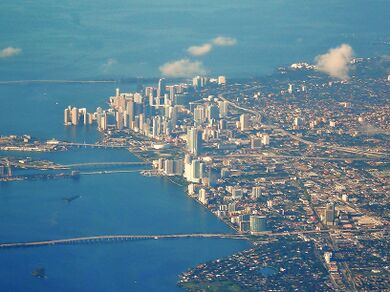
| County | 2020 Census | 2010 Census | Change | Area | Density |
|---|---|---|---|---|---|
| Miami Dade County | 2٬701٬767 | 2٬497٬993 | +8٫16% | 1،897.72 sq mi (4،915.1 km2) | 1٬424/sq mi (550/km2) |
| Broward County | 1٬944٬375 | 1٬748٬146 | +11٫22% | 1،209.79 sq mi (3،133.3 km2) | 1٬607/sq mi (621/km2) |
| Palm Beach County | 1٬492٬191 | 1٬320٬135 | +13٫03% | 1،969.76 sq mi (5،101.7 km2) | 758/sq mi (292/km2) |
| Total | 6٬138٬333 | 5٬566٬274 | +10٫28% | 5،077.27 sq mi (13،150.1 km2) | 1٬209/sq mi (467/km2) |
الإسكان
Changes in house prices for the area are publicly tracked on a regular basis using the Case–Shiller index; the statistic is published by Standard & Poor's and is also a component of S&P's 10-city composite index of the value of the residential real estate market.
As of 2005, the Miami area had a total of 2.3 million housing units, 13% of which were vacant. Of the total housing units, 52% were in single-unit structures, 45% were in multi-unit structures, and 3% were mobile homes. 25% of the housing units were built since 1990. As of 2019, over 70% of Miami's residents are renters with median rent of $1,355, $180 over the national average.
Households and families: There were 2,338,450 households, The average household size was 2.6 people. Families made up 65% of the households in the Miami area. This figure includes both married-couple families (45%) and other families (20%). Nonfamily households made up 35% of all households in Miami. Most of the nonfamily households were people living alone, but some consisted of people living in households in which no one was related to the householder.
Occupied housing unit characteristics: In 2005, the Miami area had 2.0 million occupied housing units – 1.3 million (66%) owner occupied and 688,000 (34%) renter occupied.
As of 2010, housing costs in the Miami area typically represented 40% of household income, compared to 34% nationwide.[47]
Property tax increase: In March 2009, Miami area lawmakers passed a 5–10% hike in property tax millage rates throughout the metropolitan area to fund the construction of new schools and to fund understaffed schools and educational institutions, resulting in an increase in residents' property tax bills beginning in the 2009 tax year.
السياسة
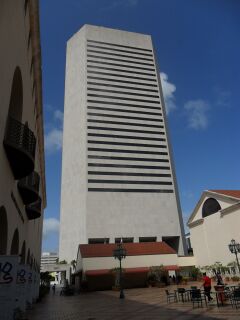
Politically, metropolitan Miami is strongly Democratic, like most large metropolitan regions in the United States. Broward County is the second-most heavily Democratic county in the state,[48][49] behind only Gadsden County, which is much smaller. This contrasts with most of the rest of Florida, whose heavier Southern influence and high population of elderly voters makes it a swing or Republican-leaning state. Miami-Dade County has a relatively high percentage of Republican voters for an urban county, due partially to its Cuban-American population, which leans Republican as a result of its anti-communist views, but Miami-Dade County still remains very Democratic when compared with most of Florida's other counties.[50][51][52] Despite being more suburban and affluent, Palm Beach County is reliably Democratic as well and in the 2020 presidential election voted for Democratic candidate Joe Biden by a higher margin than Miami-Dade County did.
In the 2016 presidential election, 62.3% of voters in the Miami metropolitan area voted Democratic. This was the 6th highest of any metro area in the United States.[53] However, in recent years the area has shifted hard to the Republicans, with former president Donald Trump losing the metro area by 16 points in 2020 compared to losing it by 30 in 2016 (Fueled especially by Miami Dade County shifting 22 points to the right between 2016 and 2020), and Governor Ron DeSantis winning the metro area outright in the 2022 gubernatorial election, winning both Miami Dade and Palm Beach Counties (With the former being won by double digits) while losing Broward only by less than 16 points. This may be attributed in part to a broader rightward shift among Hispanic voters in these years.
الحكومة
The metropolitan area is governed by 3 counties. In total there are 107 municipalities or incorporated places in the metropolis. Each one of the municipalities has its own city, town or village government, although there is no distinction between the 3 names. Much of the land in the metropolis is unincorporated, which means it does not belong to any municipality, and therefore is governed directly by the county it is located in.
دوائر الكونجرس
The Miami metropolitan area contains all or part of nine Congressional districts: the 18th, 20th, 21st, 22nd, 23rd, 24th, 25th, 26th, and 27th districts.[54] اعتبارا من 2017[تحديث] (the 113th Congress), the Cook Partisan Voting Index listed four as being Republican-leaning: the 18th, 25th, 26th, and 27th, with the 25th being the most Republican-leaning at R+5, and five as being Democratic-leaning: the 20th, 21st, 22nd, 23rd, and 24th, with the 24th being the most Democratic-leaning at D+34, making it the ninth-most Democratic-leaning district in the nation.[55]
الاقتصاد
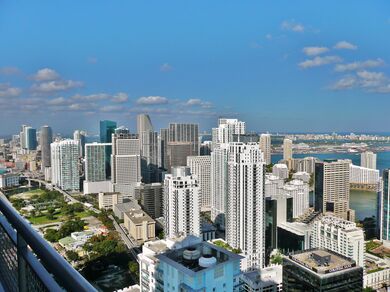
Among those employed in the Miami metropolitan area, 32% were management, professional, and related occupations, 30% were sales and office occupations, 18% were service occupations, 11% were construction, extraction, maintenance and repair occupations, and 9% were production, transportation, and material moving occupations. 81% of the people employed were Private wage and salary workers; 12% were Federal, state, or local government workers; and 7% were self-employed.
The median income of households in the Miami area was $43,091. 78% of the households received earnings and 13% received retirement income other than Social Security. 30% of the households received Social Security. The average income from Social Security was $13[بحاجة لمصدر]. These income sources are not mutually exclusive; that is, some households received income from more than one source.
In 2005, for the employed population 16 years and older, the leading industries in the Miami area were educational services, health care, and social assistance, which accounted for 18%, and Professional, scientific, and management, and administrative and waste management services, which accounted for 13% of the population. 79% of Miami area workers drove to work alone in 2005, 10% carpooled, 4% took public transportation, and 4% used other means. The remaining 3% worked at home. Among those who commuted to work, it took them on average 28.5 minutes to get to work.
Culture
Miami dialect
In Miami-Dade County a unique dialect, commonly called the Miami dialect, is widely spoken. The dialect developed among second- or third-generation Hispanics, including Cuban-Americans, whose first language was English, though some non-Hispanic white, black, and other races who were born and raised in Miami-Dade tend to adopt it as well.[56] It is based on a fairly standard American accent but with some changes very similar to dialects in the Mid-Atlantic, especially the New York area dialect, Northern New Jersey English, and New York Latino English. Unlike Virginia Piedmont, Coastal Southern American, and Northeast American dialects and Florida Cracker dialect of the Miami accent is rhotic; it also incorporates a rhythm and pronunciation heavily influenced by Spanish in which rhythm is syllable-timed.[57]
It is possible to differentiate the Miami accent from a variety of interlanguages spoken by second-language speakers. THE Miami accent does not generally display addition of /ɛ/ before initial consonant clusters with /s/, speakers do not confuse of /dʒ/ with /j/, (e.g., Yale with jail), and /r/ and /rr/ are pronounced as [[Alveolar approximant|alveolar approximant [ɹ]]] instead of alveolar tap [ɾ] or alveolar trill [r] in Spanish.[58][59][60][61]
The Miami accent is much less common in Broward County and Palm Beach County, where the majority of the population is non-Hispanic.
Area codes
- 305: Miami-Dade County and the Florida Keys; overlaid by 786
- 786: Miami-Dade County and the Florida Keys; overlays 305
- 954: All of Broward County: Fort Lauderdale, Hollywood, Coral Springs, Pompano Beach, overlaid by 754
- 754: All of Broward County: Fort Lauderdale, Hollywood, Coral Springs, Pompano Beach, overlays with 954
- 561: All of Palm Beach County: West Palm Beach, Boca Raton, Boynton Beach, Delray Beach, will be overlaid by 728
- 728: All of Palm Beach County: West Palm Beach, Boca Raton, Boynton Beach, Delray Beach, will overlay with 561
الإعلام
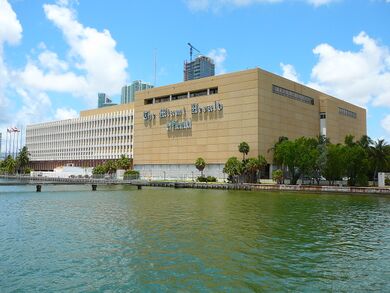
Greater Miami is served by several English-language and two major Spanish-language daily newspapers. The Miami Herald, headquartered in Doral, is Miami's primary newspaper with over a million readers. It also has news bureaus in Broward County, Monroe County, and Nassau, Bahamas. The South Florida Sun-Sentinel circulates primarily in Broward and southern Palm Beach counties and also has a news bureau in Havana, Cuba. The Palm Beach Post serves mainly Palm Beach County, especially the central and northern regions, and the Treasure Coast. The Boca Raton News publishes five days a week and circulates in southern Palm Beach County.[62] El Nuevo Herald, a subsidiary of the Miami Herald, and Diario Las Americas,[63] are Spanish-language daily papers that circulate mainly in Miami-Dade County. La Palma and El Sentinel are weekly Spanish newspapers published by the Palm Beach Post and Sun-Sentinel, respectively, and circulate in the same areas as their English-language counterparts.
There are several university student-run newspapers in the area, including The Miami Hurricane at the University of Miami, University Press at Florida Atlantic University, PantherNOW at Florida International University, and The Current at Nova Southeastern University.
Greater Miami is split into two separate television/radio markets: The Miami-Fort Lauderdale market serves Miami-Dade, Broward and the Florida Keys. The West Palm Beach market serves Palm Beach County and the Treasure Coast region.
Miami-Fort Lauderdale is the 12th largest radio market and the 16th-largest television market in the U.S. television stations serving the Miami-Fort Lauderdale area include WAMI-TV (UniMas), WBFS-TV (MyNetworkTV), WSFL-TV (The CW), WFOR-TV (CBS), WHFT-TV (TBN), WLTV (Univision), WPLG (ABC), WPXM (ION), WSCV (Telemundo), WSVN (FOX), WTVJ (NBC), WLRN-TV (PBS), and WPBT (also PBS), the latter television station being the only channel to serve the entire metropolitan area.
In addition to the Miami-Fort Lauderdale market, West Palm Beach has its own. It is the 49th largest radio market and the 38th-largest television market in the U.S. Television stations serving the West Palm Beach area include WPTV (NBC), WPEC (CBS), WPBF (ABC), WFLX (FOX), WTVX (The CW), WXEL (PBS), WTCN (MyNetworkTV), and WPXP (ION). The West Palm Beach market shares use of WSCV and WLTV for Telemundo and Univision respectively. Also, both markets cross over and tend to be available interchangeably between both areas. In 2015, WPBT and WXEL merged their operations, to form South Florida PBS, although both stations have maintained separate programming schedules and social media platforms, but share the same subchannel lineup.
Education
In Florida, each county is also a school district. Each district is headed by an elected school board. A professional superintendent manages the day-to-day operations of each district, who is appointed by and serves at the pleasure of the school board.
The Miami-Dade County Public School District is currently the 4th-largest public school district in the nation. The School District of Palm Beach County is the 4th-largest in Florida and the 11th-largest in the United States. Broward County Public School District is the 6th-largest in the United States.
The University of Miami is the one of the top-ranked research institutions in the United States, and is the most selective major university in Florida.
اعتبارا من 2023[تحديث], Florida International University is ranked the 8th largest public university by enrollment in the United States.
Some colleges and universities in Greater Miami include:
- Barry University (private/Catholic)
- Broward College (public)
- Carlos Albizu University (private)
- Chamberlain University (private)
- Florida Atlantic University (public)
- Florida International University (public)
- Florida Memorial University (private/Baptist)
- Florida National University (private)
- Jersey College (private)
- Keiser University (private)
- Lynn University (private)
- Miami Dade College (public)
- Northwood University (private)
- Nova Southeastern University (private)
- Palm Beach Atlantic University (private/Christian)
- Palm Beach State College (public)
- St. Thomas University (private/Catholic)
- University of Miami (private)
In 2005, 82% of people 25 years and over had at least graduated from high school and 28% had a bachelor's degree or higher. Among people 16 to 19 years old, 7% were dropouts; they were not enrolled in school and had not graduated from high school. The total school enrollment in the Miami metro area was 1.4 million in 2005. Nursery school and kindergarten enrollment was 170,000 and elementary or high school enrollment was 879,000. College or graduate school enrollment was 354,000.
Transportation
قالب:Rail transport in South Florida
Roads
The Miami metropolitan area is served by five interstate highways operated by the Florida Department of Transportation (FDOT) in conjunction with local agencies. Interstate 95 (I-95) runs north to south along the coast, ending just south of Downtown Miami at South Dixie Highway (US 1). I-75 runs east to west, turning south in western Broward County and connecting suburban north Miami-Dade to Naples on the Southwest Coast via Alligator Alley, which transverses the Florida Everglades before turning north. I-595 connects the Broward coast and Downtown Fort Lauderdale to I-75 and Alligator Alley. In Miami, I-195 and I-395 relay the main I-95 route east to Biscayne Boulevard (US 1) and Miami Beach across Biscayne Bay via the Julia Tuttle and MacArthur causeways.
In greater Miami, the Miami-Dade Expressway Authority and Florida's Turnpike Enterprise (FTE) maintain eight state expressways in conjunction with FDOT. The Airport Expressway (SR 112) and the Dolphin Expressway (SR 836) relay western Miami-Dade suburbs to the eastern urban coast at I-95, and to Miami Beach via I-195 and I-395 at the Airport and Midtown interchanges. The Gratigny Parkway (SR 924) connects northern Miami suburbs to the southern end of I-75. The Palmetto Expressway (SR 826) is the primary beltway road of urban Miami, relaying I-95 and Florida's Turnpike (SR 91) at the Golden Glades Interchange near northeastern North Miami Beach to the southern inland suburbs of Kendall and Pinecrest. The Don Shula Expressway (SR 874) and the Homestead Extension of Florida's Turnpike (SR 821) form the southernmost end of the beltway, connecting the Palmetto Expressway to the bedroom communities of Homestead and Florida City. The Snapper Creek Expressway (SR 878) relays the Don Shula Expressway to South Dixie Highway (US 1).
The urban bypass expressway in greater Fort Lauderdale is the Sawgrass Expressway (SR 869), connecting the northern Broward County coast at I-95 and Deerfield Beach to I-595 and I-75 at Alligator Alley in Sunrise.
Express lanes on I-95 start in Miami-Dade County and continue into Broward County. With an increased presence of traffic in South Florida, it is projected that express lanes will soon be implemented in southern Palm Beach County.
Major freeways and tollways
 Interstate 95
Interstate 95 Interstate 75
Interstate 75 Interstate 195 /
Interstate 195 /  State Road 112 (Airport Expressway)
State Road 112 (Airport Expressway) Interstate 395 /
Interstate 395 /  State Road 836 (Dolphin Expressway)
State Road 836 (Dolphin Expressway) Interstate 595 (Port Everglades Expressway)
Interstate 595 (Port Everglades Expressway) Florida's Turnpike, including Homestead Extension
Florida's Turnpike, including Homestead Extension State Road 924 (Gratigny Parkway)
State Road 924 (Gratigny Parkway) State Road 874 (Don Shula Expressway)
State Road 874 (Don Shula Expressway) State Road 878 (Snapper Creek Expressway)
State Road 878 (Snapper Creek Expressway) State Road 869 (Sawgrass Expressway)
State Road 869 (Sawgrass Expressway) State Road 826 (Palmetto Expressway)
State Road 826 (Palmetto Expressway)
Major airports
The metropolitan area is served by three major commercial airports. These airports combine to make the fourth largest domestic origin and destination market in the United States, after New York City, Los Angeles, and Chicago.[64]
| Airport | IATA code | County | FAA Category |
|---|---|---|---|
| Miami International Airport | MIA | Miami-Dade | Large Hub |
| Fort Lauderdale – Hollywood International Airport | FLL | Broward | Large Hub |
| Palm Beach International Airport | PBI | Palm Beach | Large Hub |
The following smaller general aviation airports are also in the metro area:
Seaports

The metropolis also has four seaports, the largest and most important being the Port of Miami. Others in the area include Port Everglades, Port of Palm Beach and the Miami River Port. On August 21, 2012, PortMiami and the U.S. Army Corps of Engineers signed the Partnership Agreement (PPA) construction agreement that will allow the Deep Dredge project to go out for bid. The Deep Dredge will deepen the Port's existing channels to minus 50/52 feet to prepare for the Panama Canal expansion, now scheduled for completion in early 2015. PortMiami's deeper channel will provide ships with an economically efficient, reliable and safe navigational route into the Port. PortMiami will be the only U.S. Port south of Norfolk, Virginia to be at the minus 50 foot depth in sync with the opening of the expanded Canal. Deep Dredge is expected to create more than 30,000 direct, indirect, and induced jobs in Florida and allow the Port to meet its goal to double its cargo traffic over the next decade.
Public transportation
Miami-Dade Transit (MDT) is the largest public transit agency in Florida, operating rapid transit, people movers, and an intercity bus system. Metrorail is Florida's only rapid transit, currently with 23 stations on a 24.4-ميل (39.3 km) track. The Downtown Miami people mover, Metromover, operates 20 stations and three lines on a 4.4-ميل (7.1 km) track through the Downtown neighborhoods of the Arts & Entertainment District, the Central Business District, and Brickell. Metrobus serves the entirety of Miami-Dade County, also serving Monroe County as far south as Marathon, and Broward County as far north as Downtown Fort Lauderdale. In Broward County, Broward County Transit runs public buses, as does Palm Tran in Palm Beach County. Additionally, the South Florida Regional Transportation Authority operates Tri-Rail, a commuter rail train that connects the three of the primary cities of South Florida (Miami, Fort Lauderdale, and West Palm Beach), and most intermediate points. Brightline provides service to Miami, Aventura, West Palm Beach, Fort Lauderdale, Boca Raton, and Central Florida's Orlando, with talks to expand to Tampa and Jacksonville.[65][66]
Sports
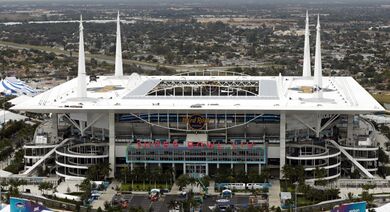
Professional
The Miami metro area is home to five major league professional sports teams:
- The Miami Dolphins of the National Football League play at Hard Rock Stadium in Miami Gardens
- The Inter Miami CF of Major League Soccer play at Inter Miami CF Stadium in Fort Lauderdale
- The Miami Heat of the National Basketball Association play at Miami-Dade Arena in Downtown Miami
- The Miami Marlins of Major League Baseball play at Marlins Park in Little Havana
- The Florida Panthers of the National Hockey League play at BB&T Center in Sunrise
College sports
The most prominent college sports program in the Miami metropolitan area are the Miami Hurricanes of the University of Miami in Coral Gables, who compete in Division I of the National Collegiate Athletic Association, the highest level of collegiate athletics.[67] The University of Miami's football team has won five national championships since 1983 and its baseball team has won four national championships since 1982.
Other collegiate sports programs in the metropolitan area include the Florida Atlantic Owls of Florida Atlantic University in Boca Raton, the FIU Panthers of Florida International University in University Park, the Nova Southeastern Sharks of Nova Southeastern University in Davie, and the Barry Buccaneers of Barry University in Miami Shores.
Minor league and other sports
The Miami area is also host to minor league sports teams, including:
- The Miami Marlins and St. Louis Cardinals conduct spring training in Jupiter at Roger Dean Stadium.
- The Houston Astros and Washington Nationals conduct spring training in West Palm Beach at The Ballpark of the Palm Beaches.[68][69][70]
- Inter Miami CF will have a reserve team that will play in USL League One.
- The Homestead-Miami Speedway oval has hosted NASCAR Cup Series and IndyCar Series events. Temporary street circuits at Museum Park hosted several CART, IMSA GT, and American Le Mans Series races between from 1986 to 1995, as well as a Formula E race in 2015. The Palm Beach International Raceway is a minor road course.
| Club | Sport | League | Venue (Capacity) | Attendance | League Championships |
|---|---|---|---|---|---|
| Miami Dolphins | Football | National Football League | Hard Rock Stadium (64,767) | 70,035 | Super Bowl (2) — 1972, 1973 |
| Miami Heat | Basketball | National Basketball Association | Kaseya Center (19,600) | 19,710 | NBA Finals (3) — 2006, 2012, 2013 |
| Miami Marlins | Baseball | Major League Baseball | LoanDepot Park (36,742) | 21,386 | World Series (2) — 1997, 2003 |
| Inter Miami CF | Soccer | Major League Soccer | Inter Miami CF Stadium | ||
| Florida Panthers | Hockey | National Hockey League | FLA Live Arena (19,250) | 10,250 | None |
| Miami Hurricanes | Football | NCAA D-I (ACC) | Hard Rock Stadium (64,767) | 53,837 | National titles (5) — 1983, 1987, 1989, 1991, 2001 |
| Florida Atlantic Owls | Football | NCAA D-1 (AAC) | FAU Stadium (29,571) | 18,948 | None |
| FIU Panthers | Football | NCAA D-I (Conference USA) | FIU Stadium (23,500) | 15,453 | None |
DRV PNK Stadium, home stadium of Inter Miami of the MLS
Kaseya Center, home of the Miami Heat of the NBA
LoanDepot Park, home of the Miami Marlins of the MLB
FLA Live Arena, home of the Florida Panthers
FAU Stadium, home of the Florida Atlantic Owls
Riccardo Silva Stadium, home of the FIU Panthers
انظر أيضاً
- جنوب فلوريدا
- United States metropolitan area
- Table of United States Metropolitan Statistical Areas
- Largest metropolitan areas in the Americas
ملاحظات
المراجع
- ^ أ ب ت "Revised Delineations of Metropolitan Statistical Areas, Micropolitan Statistical Areas, and Guidance on the Uses of the Delineations of These Areas" (PDF). Executive Office of the President. March 6, 2020. p. 26. Retrieved January 3, 2020.
- ^ "U.S. Census Bureau QuickFacts: Miami-Dade County, Florida; Broward County, Florida; Palm Beach County, Florida".
- ^ "Revised Delineations of Metropolitan Statistical Areas, Micropolitan Statistical Areas, and Guidance on the Uses of the Delineations of These Areas" (PDF). Executive Office of the President. March 6, 2020. p. 59. Retrieved January 3, 2020.
- ^ Williams, Darlene F. (2005). "Proposed Metropolitan Area Definitions for FY2006 Income Limits and Estimates of Median Family Income". Federal Register: 74988–74993. Retrieved January 12, 2011.
- ^ John Mark Ockerbloom (January 1, 2011). "Miami Metropolitan Area (Fla.)". The Online Books Page. University of Pennsylvania. Retrieved January 12, 2011.
- ^ "CONSUMER EXPENDITURES FOR THE MIAMI AREA: 2008–09" (PDF). News Release. United States Department of Labor (Bureau of Labor Statistics). October 28, 2010. Archived from the original (PDF) on April 7, 2014. Retrieved January 12, 2011.
- ^ "Journey-To-Work Trends in the United States and its Major Metropolitan Areas 1960–1990". Research and Innovative Technology Administration National Transportation Library. Federal Highway Administration. June 2003. Archived from the original on March 3, 2016. Retrieved January 12, 2011.
- ^ PDFMiami-Fort Lauderdale-Pompano Beach: Linear & Visionless – retrieved August 2, 2006
- ^ USA Urbanized Areas Over 500,000: 2000 Rankings – Rank by Density – URL retrieved September 5, 2006
- ^ Lists of Census 2000 Urbanized Areas and Urban Clusters Archived يونيو 13, 2002 at the Wayback Machine – URL retrieved August 27, 2006
- ^ NOTE: large (2.8 MB) PDF file – UMiami, Florida Urbanized Area Outline Map, 2000 Census – URL retrieved August 27, 2006
- ^ State-sorted list for UCs – URL retrieved August 27, 2006
- ^ "The NCES Fast Facts Tool provides quick answers to many education questions (National Center for Education Statistics)".
- ^ أ ب "Florida Population: Census Summary 2020" (PDF). University of Florida Bureau of Economic and Business Research. 2021. p. 27–29. Retrieved May 21, 2023.
- ^ "List II - Consolidated Metropolitan Statistical Areas and Primary Metropolitan Statistical Areas" (PDF). White House Office of Management and Budget. June 30, 1995. Archived from the original (PDF) on August 9, 2017. Retrieved 2023-05-23.
- ^ "OMB Bulletin No. 03-04 - Attachment" (PDF). White House Office of Management and Budget. June 6, 2003. p. 39. Archived from the original (PDF) on August 9, 2017. Retrieved May 22, 2023.
- ^ "Revised Delineations of Metropolitan Statistical Areas, Micropolitan Statistical Areas, and Guidance on the Uses of the Delineations of These Areas" (PDF). Executive Office of the President. March 6, 2020. p. 136. Retrieved January 3, 2020.
- ^ "OMB Bulletin No. 13-1: Revised Delineations of Metropolitan Statistical Areas, Micropolitan Statistical Areas, and Combined Statistical Areas, and Guidance on Uses of the Delineations of These Areas" (PDF). U.S. Bureau of Labor Statistics. February 28, 2013. Retrieved February 28, 2023.
- ^ "OMB Bulletin No. 18-04 - Revised Delineations of Metropolitan Statistical Areas, Micropolitan Statistical Areas, and Combined Statistical Areas, and Guidance in the Uses of These Areas" (PDF). White House Office of Management and Budget. September 14, 2018. Retrieved May 23, 2023.
- ^ Lamme & Oldakowski (2007), pp. 330–331.
- ^ "2020 U.S. Census data".
- ^ "Köppen Climate Classification Map: South Florida=Aw=tropical wet & dry". Archived from the original on July 6, 2011.
- ^ Climate Zones of the World, under Koppen's System. Retrieved August 8, 2006.
- ^ Weather.com Vulnerable cities: Miami, Florida Archived أبريل 27, 2006 at the Wayback Machine. Retrieved February 19, 2006.
- ^ Mean monthly maxima and minima (i.e. the highest and lowest temperature readings during an entire month or year) calculated based on data at said location from 1981 to 2010.
- ^ "NOWData - NOAA Online Weather Data". National Oceanic and Atmospheric Administration. Retrieved 2012-08-21.
- ^ "Station Name: FL WEST PALM BEACH INTL AP". National Oceanic and Atmospheric Administration. Retrieved 2018-04-13.
- ^ Minas, Isabella. "Best Times to Visit Ft Lauderdale". travel.usnews.com. USNews. Retrieved 23 August 2018.
- ^ Torres, Javier. "Climate Fort Lauderdale, FL". usclimatedata.com. US Climate Data. Retrieved 24 August 2018.
- ^ Henthorn, Dawn. "Avg Monthly Temps & Rainfall in Fort Lauderdale, FL". tripsavvy.com. Retrieved 22 August 2018.
- ^ خطأ استشهاد: وسم
<ref>غير صحيح؛ لا نص تم توفيره للمراجع المسماةNOAA - ^ Census Bureau – About Metropolitan and Micropolitan Statistical Areas Archived أبريل 1, 2013 at the Wayback Machine – retrieved Dec. 19, 2013
- ^ Census Bureau Geographic Terms and Concepts – Core Based Statistical Areas and Related Statistical Areas – retrieved Dec. 19, 2013
- ^ Metropolitan and micropolitan statistical areas defined by the Office of Management and Budget, December 2009 – retrieved July 22, 2011
- ^ أ ب https://www2.census.gov/library/publications/decennial/1990/population-of-states-and-counties-us-1790-1990/population-of-states-and-counties-of-the-united-states-1790-1990.pdf[bare URL PDF]
- ^ "U.S. Census Bureau QuickFacts: Palm Beach County, Florida; Broward County, Florida; Miami-Dade County, Florida". Census.gov. Retrieved 2022-03-03.
- ^ American Community Survey Archived فبراير 14, 2020 at archive.today – retrieved January 4, 2007
- ^ American Community Survey: Narrative Profile Archived أكتوبر 28, 2011 at the Wayback Machine – retrieved August 27, 2007
- ^ "Census profile: Miami-Fort Lauderdale-Pompano Beach, FL Metro Area".
- ^ "Grid View: Table B03002 - Hispanic or Latino Origin by Race". Census Reporter.
- ^ "Grid View: Table B02001 - Race". Census Reporter.
- ^ "Adults in the Miami metro area". Pew Research Center.
- ^ Major U.S. metropolitan areas differ in their religious profiles, Pew Research Center
- ^ "America's Changing Religious Landscape". Pew Research Center: Religion & Public Life. May 12, 2015.
- ^ "Greater Miami Jewish Federation Releases New Study on Miami Jewish Population". Greater Miami Jewish Federation (in الإنجليزية). Retrieved 2020-06-05.
- ^ Comenetz, Joshua. "Jewish Maps of the United States by Counties, 2011". Berman Jewish DataBank. Retrieved September 10, 2017.
- ^ Hanks, Douglas (October 29, 2010). "Housing costs higher in South Florida". The Miami Herald. Retrieved February 22, 2011.
- ^ State:Broward Power. St. Petersburg Times. Retrieved November 14, 2006.
- ^ 2008 General Election Results Archived أكتوبر 11, 2012 at the Wayback Machine. South Florida Sun-Sentinel. Retrieved November 11, 2008.
- ^ "South Florida Sun-Sentinel.com Election 2008 (Florida Presidential election results): 2008". Sun-sentinel.com. Archived from the original on ديسمبر 2, 2011. Retrieved نوفمبر 8, 2011.
- ^ "Election 2004 (Florida Presidential election results): 2004". CNN. April 13, 1970. Retrieved November 8, 2011.
- ^ "Election 2006 (Florida Gubernatorial election results): 2006". CNN. Retrieved November 8, 2011.
- ^ "Mapping How America's Metro Areas Voted". CityLab. December 1, 2016. Retrieved April 13, 2017.
- ^ "Congressional Districts – Florida" (Map). National Atlas of the United States (PDF). Cartography by USGS. United States Geological Survey. 2013. Archived from the original (PDF) on سبتمبر 4, 2014. Retrieved أغسطس 17, 2014.
- ^ "Partisan Voting Index Districts of the 113th Congress" (PDF). The Cook Political Report. Archived from the original (PDF) on July 29, 2017. Retrieved February 20, 2019.
- ^ "Miami Accents: Why Locals Embrace That Heavy "L" Or Not". WLRN (WLRN-TV and WLRN-FM). August 27, 2013. Retrieved September 1, 2013.
- ^ "'Miami Accent' Takes Speakers By Surprise". Articles – Sun-Sentinel.com. June 13, 2004. Archived from the original on August 20, 2012. Retrieved 2012-10-08.
- ^ "Miami Accents: How 'Miamah' Turned Into A Different Sort Of Twang". WLRN (WLRN-TV & WLRN-FM). August 26, 2013. Retrieved September 1, 2013.
- ^ Haggin, Patience (August 27, 2013). "Miami Accents: Why Locals Embrace That Heavy "L" Or Not".
- ^ Watts, Gabriella (August 26, 2013). "Miami Accents: How 'Miamah' Turned Into A Different Sort Of Twang".
- ^ "English in the 305 has its own distinct Miami sound". Miami Herald. Archived from the original on ديسمبر 3, 2013. Retrieved سبتمبر 10, 2013.
- ^ Boca Raton News home page – URL retrieved August 19, 2006
- ^ "Diario Las Americas". Diario Las Americas. August 2, 2010. Retrieved November 8, 2011.
- ^ "Top 200 U.S. Airports Ranked By Domestic O&D Traffic, Year Ended March 2007" (PDF). www.eclatconsulting.com. Archived from the original (PDF) on April 8, 2008.
- ^ Davis, Ennis. "Virgin Trains expands in Florida. Will it ever reach Jacksonville?". Sarasota Herald-Tribune (in الإنجليزية). Retrieved 2020-06-05.
- ^ Newspapers, Joshua Solomon, Treasure Coast. "Virgin Trains OKs 3 new stations in South Florida, so when will it build stations here?". The Palm Beach Post (in الإنجليزية). Retrieved 2020-06-05.
{{cite web}}: CS1 maint: multiple names: authors list (link) - ^ "Miami (Florida)". National Collegiate Athletic Association. Archived from the original on November 13, 2013. Retrieved February 7, 2010.
- ^ "New first name for Ballpark of the Palm Beaches: Fitteam".
- ^ Janes, Chelsea (February 16, 2018). "Nationals and Astros reach naming rights deal for Ballpark of the Palm Beaches" – via www.washingtonpost.com.
- ^ "Astros, Nats rename FITTEAM Ballpark". MLB.com.
وصلات خارجية
 South Florida travel guide from Wikivoyage
South Florida travel guide from Wikivoyage- Populations of Metropolitan and Micropolitan Area (and rankings)
- Pages using gadget WikiMiniAtlas
- Harv and Sfn no-target errors
- All articles with bare URLs for citations
- Articles with bare URLs for citations from January 2022
- Articles with PDF format bare URLs for citations
- Webarchive template archiveis links
- Short description is different from Wikidata
- Coordinates on Wikidata
- مقالات فيها عبارات متقادمة منذ 2023
- جميع المقالات التي فيها عبارات متقادمة
- Articles with hatnote templates targeting a nonexistent page
- مقالات فيها عبارات متقادمة منذ 2017
- Articles with unsourced statements from June 2020
- Pages with plain IPA
- Miami metropolitan area
- Broward County, Florida
- Metropolitan areas of Florida
- Miami-Dade County, Florida
- Palm Beach County, Florida
- South Florida
